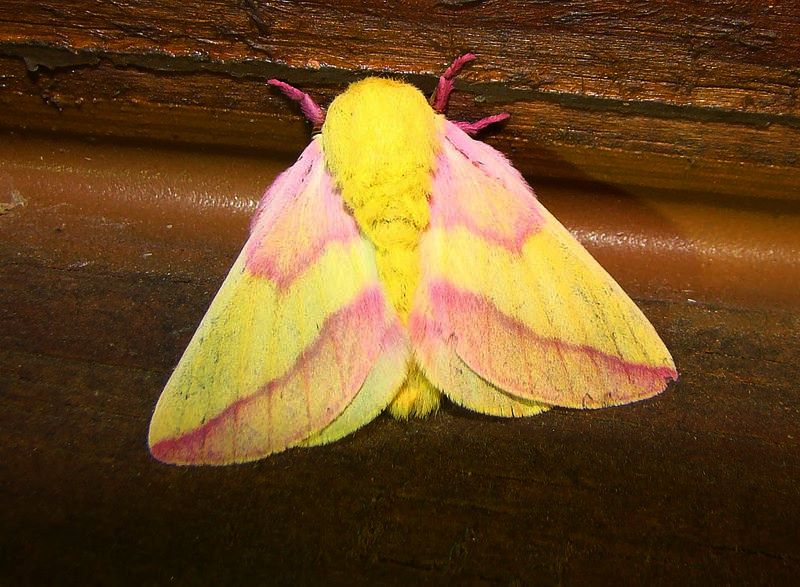Introduction
Rosy maple moth (Dryocampa rubicunda) is a silk moth in the family Saturniidae. The moth is indigineous to North America. It is notable for its wooly appearance, and variable coloration. During its nymph stage, rosy maple moth is a voracious feeder. When populations are abundant, host trees can be partially or completely defoliated. As such, the nymphs are considered an aesthetic nuisance. Successive defoliations over several years can cause host trees to become weakened, rendering them more susceptible to other environmental stressors.
Distribution & Habitat
Rosy maple moth generally infests deciduous forests, but can also be found in suburban and urban landscapes. The insect is common across the southern regions of Canada. Its range encompasses New Brunswick, Nova Scotia, Ontario, Prince Edward Island, and Quebec. In the United States, the insect’s range extends across New England, south along the Atlantic Coast to Dade County, Florida, and west from eastern Texas to Minnesota.
Hosts
Rosy maple moth infests maple trees, as well as oak trees – particularly turkey oak.
Description
Rosy maple moth is the smallest silk moth in North America. Its eggs are ovular and thin, with a smooth yellow shell. The eggs typically measure around 1.4 mm in diameter. The larvae are referred to as greenstriped mapleworms. Throughout the early instars, the larvae have large black heads, and pale yellow-green bodies, with faint green longitudinal stripes. Two large dark-green to black tubercles arise on the second segment of the thorax. Three rows of small spines, or setae, develop on either side of the body.
As the larvae progress through later instars, their heads gradually diminish in size. The longitudinal stripes also darken, turning a deep shade of red. By the final instar, the head turns yellow, before finally becoming bright red. During this period, the body turns yellow-green. By the time they have fully matured, the longitudinal stripes on the larvae may range from white to green to black. Mature larvae can reach up to 2 inches in length. The pupae are dark, elongated, and feature several small spines.
The adult females are generally larger than their male counterparts. The females’ wingspan measures 1.5 to 2 inches, while the males’ wingspan reaches between 1.25 and 1.75 inches in length. The upperside of the wing is yellow to cream to white, with pink at the margins and wing bases. The wing margins may occasionally be absent of color. The adults’ forewings are pink, with a triangular yellow band in the center. The hindwings are yellow. The legs and antennae are colored red to pink. The antennae of the males is bushier than that of the females.
Life Cycle
Rosy maple moth produces one to three generations, depending on the geographic location. One generation occurs in the northern part of its range. Two generations develop in the south, while up to three generations may be completed in the Deep South and Florida. The larvae emerge from their overwintering spots in spring. During their first three instars, the larvae are gregarious, often feeding together on the same leaf. The larvae primarily consume the underside of leaves. As the larvae mature, they begin to feed independently. Once mature, the larvae descend to the ground, and burrow into the soil. Within the soil, the larvae construct shallow chambers, which they settle in to pupate.
A few weeks later, the adults vacate their pupal chambers. The females navigate to host plants, where they emit a pheremone, which the males detect with their antennae. Once the males have located the females, they copulate. The following evening, the females that have been fertilized begin depositing eggs on the leaves of host trees. Each female lays 150 to 200 eggs in batches of 10 to 40. The eggs hatch within two weeks, revealing masses of larvae. The larvae initiate feeding, and the cycle begins anew.
Symptoms of Infestation
Severe infestations often result in the partial or complete defoliation of host trees. While this temporarily reduces the aesthetic value of the tree, most trees will produce a second flush of growth by fall.
Management
- Rose maple moth’s natural predators are mostly comprised of birds. Common predators include blue jays, black-capped chickadees, and tufted titmice. When present, these natural predators help to limit larvae and adult populations.
- Rosy maple moth is generally considered a minor pest. As such, control is seldom required. Registered insecticides can be employed to combat dense populations. Applications should be performed in spring, as the larvae become active.
Photo courtesy of Andy Reago & Chrissy McClarren CC-by-2.0


